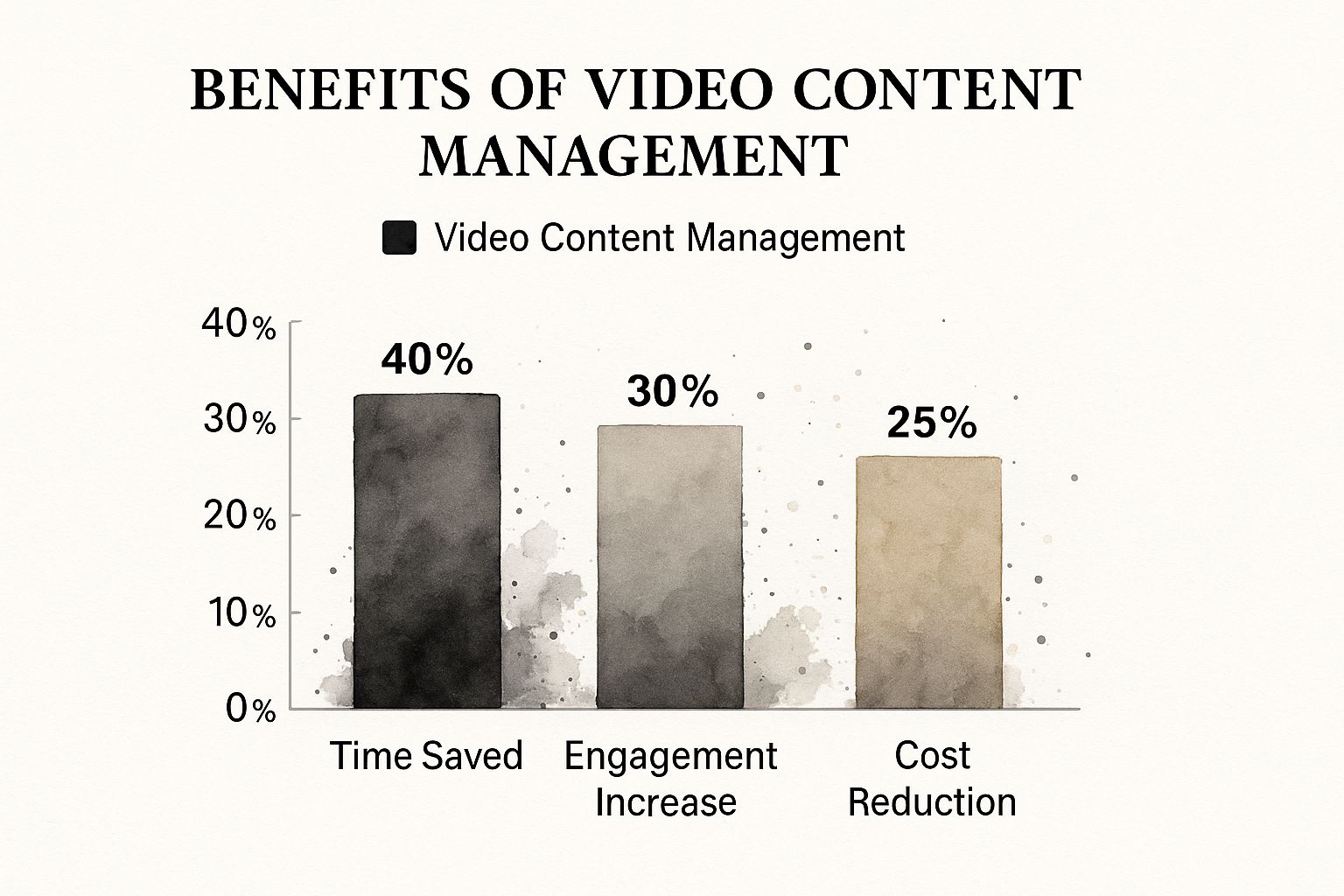In This Article
Subscribe to our newsletter
Understanding Modern Video Content Management Realities

Managing video effectively in the current environment is much more than just dropping files onto a server. The true nature of modern video content management presents a multifaceted challenge, requiring a well-thought-out plan that many businesses are still figuring out. This involves a fundamental shift in how teams approach video, from its initial creation all the way through to how it's shared.
The Evolution from Storage to Strategy
In the early days, video files might have been treated like any other digital document, tucked away in a shared folder. But as the amount of video content has exploded, along with its unique file properties and its key role in how we communicate, a more refined method became essential.
Standard content management systems often struggle because they weren't designed for video's specific demands. These include hefty file sizes, a variety of formats, and the detailed metadata vital for easy finding and usage. This gap often causes older strategies to fall apart, resulting in wasted effort and lost chances.
Unpacking Today's Video Management Challenges
As video collections grow, many companies face substantial difficulties. A frequent problem is what can be called metadata nightmares; poor tagging and organization can make locating a particular video clip a frustratingly long process, almost like finding a specific book in a library with no catalog.
Beyond just keeping things tidy internally, cross-platform optimization headaches add another challenge. A video created for a formal presentation will probably need significant changes to work effectively on fast-paced social media feeds.
The widespread use of video makes these issues even bigger. It's anticipated that by 2025, nearly all businesses will be using video marketing. Current figures show that 89% of businesses already incorporate video into their marketing efforts, highlighting its central function in promotional activities. Moreover, 95% of video marketers see video as a key component of their overall marketing plans, showing a strong dependence on video to build connections and achieve outcomes. You can find more detailed statistics here.
Adopting a Video-First Workflow for Success
To tackle these challenges, forward-thinking teams are adopting a video-first thinking approach. This goes beyond simply improving how video files are managed; it's about fundamentally reorganizing work processes to give video priority at every stage. This includes initial concept and production, all the way to specific distribution and performance review. This mindset positions video as a core element of communication strategy, rather than an afterthought.
This change in strategy includes setting up methodical ways to organize large video collections, ensuring every piece of content is simple to find, access, and reuse. For more information on building these systems, take a look at our guide on A Complete Guide to Video Content Management Systems: From Strategy to Success.
Additionally, creating scalable workflows that can expand as your organization grows, without creating operational slowdowns, is key. To make your video content management smoother, you might want to optimize your video creation workflow. The main aim is to turn what could be video chaos into a significant competitive advantage, making certain that all video content actively helps your business reach its goals.
Building Video Strategy That Actually Drives Results
Making videos today comes with its own set of hurdles, which really highlights why a solid plan is crucial. It’s not just about churning out videos anymore. Brands that are leading the pack handle their video content management by zeroing in on real business results, looking past just the surface-level numbers. This kind of organized method makes sure every video pulls its weight and helps achieve the bigger picture.
Auditing Your Existing Video Assets
Kicking off a video strategy that truly delivers starts with a straightforward look at what you already have – an audit of your existing assets. Lots of companies have a treasure trove of videos, but if they aren't properly sorted and their performance isn't checked, a lot of their potential just sits there unused.
This isn't just about tallying up how many videos you've got. It's about digging into whether they're still relevant, how good they are, and what they've achieved in the past. Think about it: are those product demos from a few years ago still on point, or are they showing off features that are long gone? Pinpointing videos that aren't doing well or are simply out-of-date is key to sharpening your game plan for what's next. Getting this clear picture is the bedrock for a better video content management system.
Establishing Clear Governance and Policies
Once you’ve got a good handle on the videos you currently have, the next vital step is setting up some governance policies. These rules of the road are super important to stop things from becoming a chaotic mess, which can easily throw a wrench in even the most well-intentioned video plans.
Good governance lays out the 'how-to' for making, green-lighting, keeping, and sharing videos. This means sorting out how you name files, what metadata (like keywords and descriptions) needs to be included, and who gets to access what. For example, a straightforward policy could demand that every marketing video has certain brand visuals and clear calls-to-action, keeping everything consistent. These kinds of guidelines are fundamental for protecting your brand's image and keeping things running smoothly within your video content management framework.
The payoff for having this kind of organized system is pretty clear when you look at how much more efficient operations can become. The infographic below shows some of the main improvements companies see when they get systematic with their video content management.

As you can see, effective video content management can slash time spent by a whopping 40%, boost engagement by 30%, and trim costs by about 25%. These are pretty compelling reasons to get organized!
Creating Content Calendars and Workflows
With these policies in place, you can then build out content calendars that help you grow steadily. Forget about making videos on the fly; a calendar lines up your video releases with your bigger marketing pushes, product unveilings, and what you want to achieve with your audience.
Setting up efficient workflows is just as critical. This involves sketching out every single step in making a video – from the first idea to getting it out there – so you can spot any hold-ups and find ways to do things better. A smart workflow, for instance, could have set review points, so key people can check the content at important junctures without slowing everything down. Think of Optimized workflows as the powerhouse behind a productive video content management strategy. If you're looking to sharpen your content game even more, you might find this useful: How to Create Engaging Content: A Complete Guide That Drives Real Results.
To better understand how these elements come together, it's helpful to look at different ways businesses might tackle their video content. Not everyone is at the same stage, and the right approach depends on your resources and goals. The following table compares various video content management strategies, from just starting out to running a full-scale operation.
Video Content Strategy Framework ComparisonA comparison of different video content management approaches, from basic to enterprise-level strategies
| Approach | Best For | Key Features | Resource Requirements | Expected Outcomes |
|---|---|---|---|---|
| Ad-hoc / Reactive | Very small teams, initial experimentation | Sporadic video creation, focus on immediate needs, minimal planning. | Low (minimal time, basic tools) | Inconsistent results, low ROI, difficult to measure impact. |
| Basic Organized | Small businesses getting serious about video | Asset audit, basic categorization, initial performance tracking. | Moderate (dedicated time for audit, simple tools) | Better understanding of existing content, identification of gaps. |
| Strategic & Governed | Growing businesses, marketing teams | Clear governance policies, content calendars, defined workflows, metadata standards, approval processes. | Significant (personnel, planning tools, CMS potential) | Consistent output, brand alignment, improved efficiency, better ROI. |
| Optimized & Iterative | Large organizations, mature video operations | Continuous performance analysis, A/B testing, advanced analytics, iterative refinement of strategy. | High (specialized teams, advanced platforms, budget) | Maximized ROI, data-driven decisions, sustained growth, market leadership. |
As the table shows, moving towards a more strategic and governed approach significantly improves outcomes. The key is to find the right level for your organization and gradually build more sophisticated processes.
Categorization, Quality, and Optimization
Sensible ways of categorizing video content can make a real difference too. Imagine sorting your videos into buckets like 'product tutorials,' 'customer success stories,' or 'quick social media clips.' This doesn't just keep things tidy on your end; it also makes it easier for your audience to find what they're looking for. Hand-in-hand with this, establishing clear quality standards means every video you put out looks and feels like your brand, no matter what it's for or where it's shown.
At the end of the day, a winning video strategy finds that sweet spot between creative ideas and smooth operations. Pros in the field get this right by treating video content management as an ongoing cycle – from dreaming up the concept all the way to tweaking its performance. They’re always looking at what’s hitting the mark, fine-tuning how they do things, and changing with what their audience wants. This constant cycle of improvement is what makes sure their videos keep delivering real business value. This iterative approach is the secret sauce for success in the long run.
Choosing Video Platforms That Won't Let You Down
 Picking the right home for your video content management is a big deal. If you choose poorly, you could face major hits to your team's efficiency and how well your videos perform. With so many choices out there, it's key to figure out what's actually important for your organization's video goals.
Picking the right home for your video content management is a big deal. If you choose poorly, you could face major hits to your team's efficiency and how well your videos perform. With so many choices out there, it's key to figure out what's actually important for your organization's video goals.
Core Capabilities for Effective Video Content Management
When you're looking at different platforms, some features are absolutely essential for smooth video content management. Take automated transcoding, for example. This is a must-have because it automatically changes your videos into different formats and sizes. This means they’ll play well on any device, no matter the internet speed, and you won't have to do it by hand.
Another game-changer is an intelligent tagging system. This isn't just about basic keywords; advanced systems use AI to suggest smart tags by looking at what’s in your video, like objects or spoken words, building detailed metadata. This makes finding and reusing your videos much easier, saving a bunch of time. Don't forget about smooth connections with your current marketing tools, like your CRM or analytics software, for a unified process.
Storage, Delivery, and Specialized Solutions
The way a platform stores and delivers your videos really affects how well they perform and how much you'll pay. Some Content Management Systems (CMS) come with solid, built-in video hosting. Others might connect with separate video hosting providers, and it's good to know the difference.
Think about this: by 2025, about 64% of all websites around the world will be using CMS software for their content. What's more, 40% of enterprises are already using CMS platforms specifically for managing and sharing their videos. This shows how important built-in video tools are becoming. You can explore more about CMS statistics.
If your company has a massive video collection or needs specific features like live streaming or interactive video, you might need to look at specialized video platforms. These are built specifically for handling lots of video and often have advanced tools you won't find in a standard CMS.
Crucial Considerations for Long-Term Success
It's not just about the features; other things play a big role in how well your video content management choice works out long-term. When it comes to cost factors, don't just look at the monthly fee. Think about extra charges for too much storage, high bandwidth use, or any special features and support you might need.
Scalability limitations are also super important. Will the platform be able to handle more videos and a bigger audience as you grow? Consider what happens if you suddenly have thousands, or even tens of thousands, of video assets to manage. Also, check out the technical requirements. Some systems are easy for anyone to use, while others might need someone with tech skills to run and adjust them.
As you map out your video plans, think about how technology can boost what you're doing. For example, there are helpful resources out there to find the best AI tools for Facebook video ads. These tools can work alongside your management system and even automate parts of getting your videos out there. Choosing wisely now will save you trouble later and help you hit your targets.
Mastering Multi-Platform Video Optimization
Getting your video content to perform well on every digital platform, without it becoming a huge operational task, requires some careful planning. It’s about effectively modifying your message while keeping your brand identity strong, regardless of where your audience views your videos. The significant presence of video highlights this necessity; reports on digital trends show that video streaming accounts for approximately 91% of global internet traffic. Furthermore, consumer video content viewing makes up 82% of all internet traffic. This points to a major move towards digital video, making platform-specific adjustments vital for reach and making an impact. Explore these video marketing statistics in more detail.
Adapting Content for Diverse Digital Stages
Modifying your video for different platforms is key to effective video content management. Each platform has its unique audience expectations and technical specifications. For example, aspect ratios are very important; a widescreen 16:9 video that's perfect for YouTube might look awkwardly cropped on TikTok, which prefers a vertical 9:16 format. Meanwhile, Instagram often favors 1:1 or 4:5 ratios.
Beyond just the dimensions, video duration strategies also differ greatly. Viewers on platforms like X (formerly Twitter) or Instagram Stories look for short, attention-grabbing content, often under 60 seconds. In contrast, your own website or a dedicated learning portal can feature longer, more detailed videos. This means one core piece of content might need to be edited into several length variations.
Moreover, captions are essential these days. A large number of users watch videos with the sound off, particularly on mobile devices or in public settings. Including accurate, easy-to-read captions greatly improves accessibility and engagement. Equally important are compelling thumbnails; they create the first impression and can significantly affect click-through rates, making them a critical part of your video content management efforts.
Smart Repurposing: Making Content Work Harder
Effective video content management also means getting the most out of every piece of footage you create. Systematic repurposing helps you extend the life and reach of your long-form content. For instance, a detailed webinar can be transformed into:
- Multiple short clips that highlight key takeaways for social media.
- An audio track suitable for a podcast episode.
- Quote graphics that feature impactful statements.
- A blog post summarizing the main points discussed.
This method doesn't weaken your message; instead, it adjusts it to suit different viewing habits and platforms, ensuring your central ideas reach a broader audience. Repurposing existing assets is much more efficient than constantly producing new content from scratch. This maximizes your investment and makes your video content management workflow smoother.
Maintaining Sanity with Version Control and Frameworks
Managing multiple versions of the same basic video can quickly turn into a mess without solid version control strategies. Simple mistakes, such as publishing a draft or an outdated version, can be damaging and harm your brand. Implementing clear naming conventions (for example, VideoTitle_Platform_AspectRatio_Date) and detailed metadata for each version is crucial for organized video content management.
Additionally, establishing proven frameworks for managing content variations across social media, websites, email campaigns, and new channels helps keep operations efficient. This might include using specialized video content management tools that offer versioning support, or developing clear internal workflows and checklists. The objective is to ensure consistency and quality, no matter where the video is published, which helps prevent problems and makes your team more productive.
Measuring Video Performance That Actually Matters

Relying on view counts alone gives you a very narrow perspective on your video's real influence. The true measure of video content success, particularly when using a strategic video content management approach, comes from metrics that genuinely forecast business results. Grasping these crucial indicators is key to refining your content and demonstrating its worth.
Moving Beyond Vanity Metrics
It's natural to feel good about high view counts initially, but it's vital to dig deeper. Vanity metrics, such as total views by themselves, often don't line up with actual business achievements. Instead, concentrate on numbers that show how your audience is truly interacting with your material. For example, engagement rate (which looks at likes, comments, and shares compared to views) and play-through rate (the average portion of a video people watch) provide much more meaningful information about how well your content connects.
These figures paint a clearer picture of whether your video is truly holding your audience's attention or if they're clicking away after only a few seconds. A high play-through rate, for instance, indicates that your content is keeping viewers engaged, a core objective for any video. This change in focus is a cornerstone of effective video content management.
Uncovering Audience Behavior with Deeper Analytics
To genuinely understand how viewers engage, explore audience retention reports. These charts show precisely where viewers tend to leave, offering precious hints about which parts of your video are working and which might need a second look. Maybe your intro is too lengthy, or a specific segment isn't quite hitting the mark.
Also, monitoring click-through rates (CTR) on any calls-to-action (CTAs) included in or alongside your videos directly shows how effectively your content motivates viewers to act. Sophisticated video content management systems often come with built-in analytics or can connect with specialized tools to gather this detailed data, helping turn behavioral observations into practical steps for improving content.
Linking Video Performance to Tangible Business Outcomes
The main aim of most video content is to support business goals. Because of this, tracking conversion rates is extremely important. This involves measuring how many viewers take a desired action after watching a video, like signing up for a newsletter, asking for a demo, or buying something. For instance, if a product demonstration video leads to a 15% increase in "add to cart" clicks, that’s a strong signal of its effectiveness.
Calculating video Return on Investment (ROI) means comparing production and promotion costs against the revenue or value it brings in. A methodical approach to video content management makes sure that tracking measures are consistently used for all video materials, making ROI calculations more precise and easier to defend.
To effectively track and analyze your video's impact, it's useful to identify specific metrics that align with your goals. The following table, "Essential Video Content Management Metrics," details key performance indicators for measuring video content success across various objectives.
| Metric Category | Key Indicators | What It Measures | Optimization Actions | Industry Benchmarks |
|---|---|---|---|---|
| Audience Reach | Views, Unique Viewers, Impressions | The total number of times your video was seen and by how many distinct individuals. | Optimize video titles, descriptions, and metadata for search; promote across multiple channels. | Varies by platform and promotion effort |
| Engagement | Likes, Comments, Shares, Average View Duration, Play-Through Rate | How viewers interact with and consume your video content. | Create more compelling intros, use clear visuals, encourage interaction, refine content based on drop-off points. | Generally, 2-5% is a good starting point |
| Audience Retention | Watch Time, Audience Retention Graphs | The percentage of your video that viewers watch and where they stop watching. | Analyze drop-off points to identify less engaging or confusing segments; improve storytelling and pacing. | Aim for 50-60% for strong performance |
| Conversion | Click-Through Rate (CTR) on CTAs, Lead Generation Forms, Sales Attributed to Video | How effectively your video drives desired actions and contributes to business goals. | Make CTAs clear and compelling; place them strategically (e.g., mid-roll, end-screen); ensure landing pages are optimized. Learn more in our article about How to Craft a Video Content Strategy to Boost Engagement and Conversions. | Varies widely based on CTA and audience |
This table provides a framework for understanding which metrics to monitor and how they contribute to overall video strategy, helping you to focus on data that drives improvement and demonstrates value.
Using Insights to Refine and Report
The data you collect isn't just for looking at; it’s for taking action. Performance information should directly shape strategic choices for future content spending and improvements within your video content management systems. If analytics reveal that shorter, tutorial-style videos have better completion rates and bring in more qualified leads, it’s logical to put more resources into that type of content.
When presenting to stakeholders, convert these metrics into the language of business results. Illustrate how video initiatives are helping to achieve wider company objectives, thereby justifying resource use and highlighting the effectiveness of a data-informed strategy. By concentrating on performance indicators that truly count, you change video from a potential expense into a clear source of value.
Scaling Video Operations Without Losing Your Mind
Increasing your video output can be thrilling, yet it usually introduces difficult problems. When faced with a surge of new videos, how do you maintain quality and prevent team exhaustion? This is a frequent obstacle, but numerous companies have successfully scaled their video content management from handling just a few dozen assets to managing thousands, all while keeping operations smooth.
The Balancing Act: More Videos, Same High Standards
When your video production increases, keeping up the quality that first made you successful becomes a significant challenge. What worked for a small number of videos each month might not hold up when you're producing content daily or even more frequently. It's not merely a question of storage; it’s about making sure every new video reflects your brand, message, and quality expectations – a key part of good video content management.
The main aim is to avoid disorder in your operations and prevent your team from feeling overwhelmed, making sure your expansion is manageable in the long run. Businesses that manage this stage well usually take a fresh look at their video content management strategies when they reach these critical growth points.
Smart Automation for Sustainable Growth
A powerful method to handle a greater number of videos without equally increasing manual work is through smart automation. Though "automation" might seem like a common term, specific uses can significantly ease the strain in a growing video setup. For instance, automated transcoding, which helps convert video formats, becomes essential when dealing with large volumes, making sure videos are swiftly ready for different platforms without needing someone to do it by hand. This gives your team more time for important planning.
AI-assisted metadata tagging can also be extremely helpful when managing thousands of video files. Think about a video content management system that automatically proposes useful tags, converts audio to text for captions and easier searching, or even pinpoints important segments in your videos. Such automated steps greatly cut down on manual data input and make it easier to find content in your growing collection. Automation can also apply to sharing content, sending approved videos to the right places on a set schedule, making the video content management process even smoother.
Strategic automation in expanding video operations can lead to:
- Less manual work on repeated jobs like transcoding and tagging.
- Quicker delivery from creation to going live.
- More uniform metadata and formatting.
- Smarter use of team members, letting them concentrate on imaginative and strategic tasks.
Structuring Teams and Workflows for Volume
While technology helps a lot, your team's organization and workflow design are just as important for scaling video content management. When you're handling more videos, a job that one person could do easily before might now slow things down. You might need to think about creating specific roles, such as a full-time video editor, someone to manage distribution, or an administrator for your video content management system. Having clear roles helps ensure tasks get done and everyone knows what they're responsible for.
Making your workflow optimizations becomes very important too. This means looking closely at each part of how you make and manage videos to find and remove any steps that are repetitive or don't add value. For example, setting up efficient approval workflows within your video content management tool can help keep quality high without big hold-ups. These systems should let people review and give feedback easily, with automatic updates to keep projects on track, ensuring videos progress smoothly from start to finish, even with many to handle.
Governing a Growing Video Universe
Overseeing a constantly increasing collection of videos and keeping everything consistent across many content channels demands strong governance, particularly if your teams work in different places. Good video content management for large operations relies on solid plans for managing large video libraries. This involves key actions like:
- Putting strict version control in place, so everyone uses the right files and old content isn't mistakenly shared.
- Setting up clear rules for archiving older or less important content, which helps keep your main library easy to use and efficient.
- Making sure everyone follows the same metadata rules to keep the entire library searchable and well-organized.
Keeping up content governance across distributed teams can be tough but is essential for protecting your brand's image. Regular training, easy-to-find clear instructions within your video content management setup, and central supervision help make sure everyone follows brand rules and quality levels, no matter where they are. This uniformity is key so that every video, from the first few to the thousands that follow, properly represents your company and connects with your viewers. Successful scaling means your video management methods adapt to growth while maintaining the quality that brings success.
Expanding your video work often begins with making the creation process more efficient. If you aim to create more high-quality video content without overburdening your team, see how Aeon, a video production automation tool, can automate and make your video production simpler. Discover Aeon and transform your content strategy today at https://www.project-aeon.com.






.jpg)